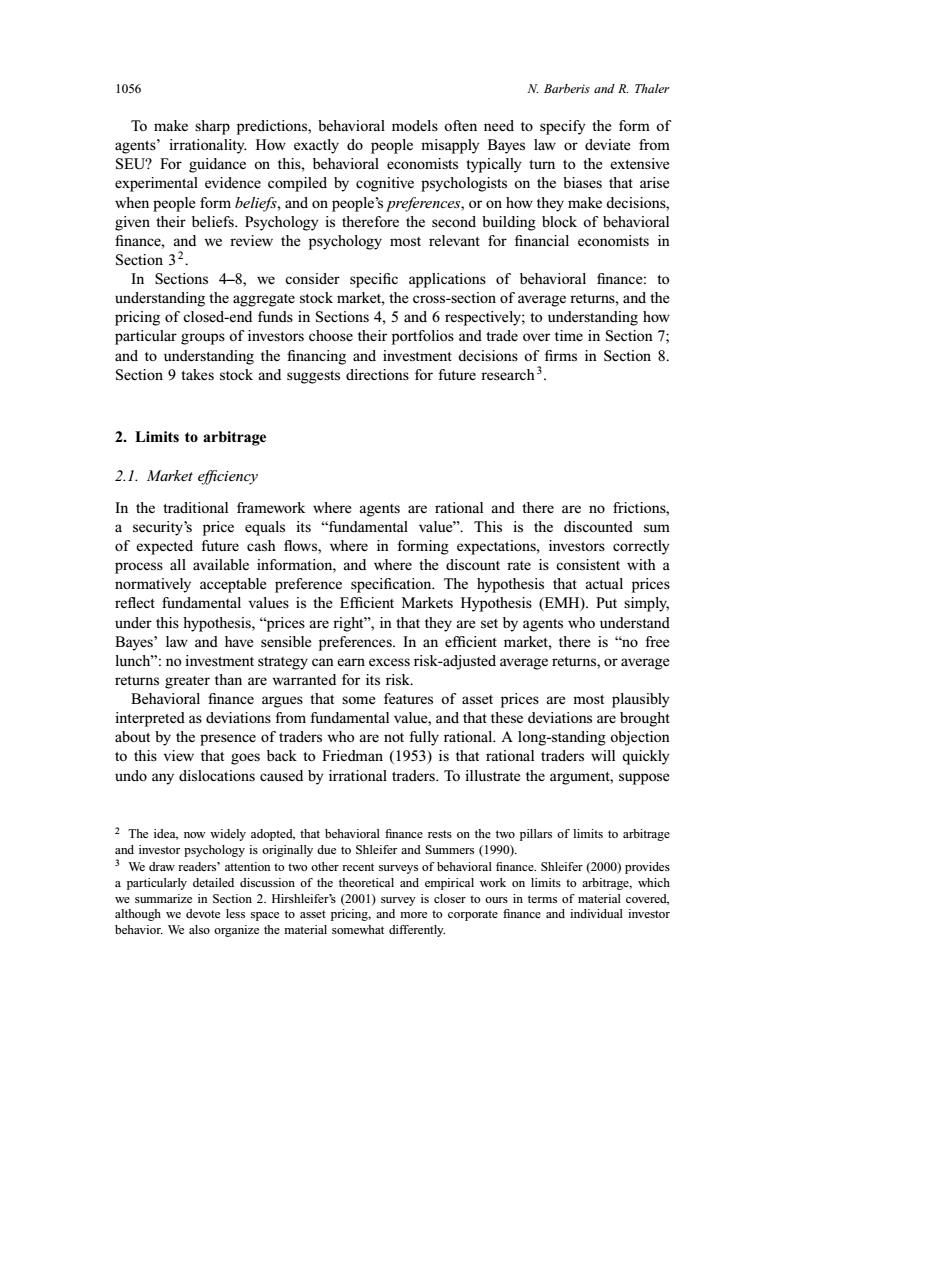正在加载图片...

1056 N.Barberis and R.Thaler To make sharp predictions,behavioral models often need to specify the form of agents'irrationality.How exactly do people misapply Bayes law or deviate from SEU?For guidance on this,behavioral economists typically turn to the extensive experimental evidence compiled by cognitive psychologists on the biases that arise when people form beliefs,and on people's preferences,or on how they make decisions, given their beliefs.Psychology is therefore the second building block of behavioral finance,and we review the psychology most relevant for financial economists in Section 32. In Sections 48,we consider specific applications of behavioral finance:to understanding the aggregate stock market,the cross-section of average returns,and the pricing of closed-end funds in Sections 4,5 and 6 respectively;to understanding how particular groups of investors choose their portfolios and trade over time in Section 7; and to understanding the financing and investment decisions of firms in Section 8. Section 9 takes stock and suggests directions for future research3. 2.Limits to arbitrage 2.1.Market efficiency In the traditional framework where agents are rational and there are no frictions. a security's price equals its "fundamental value".This is the discounted sum of expected future cash flows,where in forming expectations,investors correctly process all available information,and where the discount rate is consistent with a normatively acceptable preference specification.The hypothesis that actual prices reflect fundamental values is the Efficient Markets Hypothesis(EMH).Put simply, under this hypothesis,"prices are right",in that they are set by agents who understand Bayes'law and have sensible preferences.In an efficient market,there is "no free lunch":no investment strategy can earn excess risk-adjusted average returns,or average returns greater than are warranted for its risk. Behavioral finance argues that some features of asset prices are most plausibly interpreted as deviations from fundamental value,and that these deviations are brought about by the presence of traders who are not fully rational.A long-standing objection to this view that goes back to Friedman (1953)is that rational traders will quickly undo any dislocations caused by irrational traders.To illustrate the argument,suppose 2 The idea,now widely adopted,that behavioral finance rests on the two pillars of limits to arbitrage and investor psychology is originally due to Shleifer and Summers (1990). 3We draw readers'attention to two other recent surveys of behavioral finance.Shleifer(2000)provides a particularly detailed discussion of the theoretical and empirical work on limits to arbitrage,which we summarize in Section 2.Hirshleifer's (2001)survey is closer to ours in terms of material covered, although we devote less space to asset pricing,and more to corporate finance and individual investor behavior.We also organize the material somewhat differently.1056 N. Barberis and R. Thaler To make sharp predictions, behavioral models often need to specify the form of agents’ irrationality. How exactly do people misapply Bayes law or deviate from SEU? For guidance on this, behavioral economists typically turn to the extensive experimental evidence compiled by cognitive psychologists on the biases that arise when people form beliefs, and on people’s preferences, or on how they make decisions, given their beliefs. Psychology is therefore the second building block of behavioral finance, and we review the psychology most relevant for financial economists in Section 32. In Sections 4–8, we consider specific applications of behavioral finance: to understanding the aggregate stock market, the cross-section of average returns, and the pricing of closed-end funds in Sections 4, 5 and 6 respectively; to understanding how particular groups of investors choose their portfolios and trade over time in Section 7; and to understanding the financing and investment decisions of firms in Section 8. Section 9 takes stock and suggests directions for future research 3. 2. Limits to arbitrage 2.1. Market efficiency In the traditional framework where agents are rational and there are no frictions, a security’s price equals its “fundamental value”. This is the discounted sum of expected future cash flows, where in forming expectations, investors correctly process all available information, and where the discount rate is consistent with a normatively acceptable preference specification. The hypothesis that actual prices reflect fundamental values is the Efficient Markets Hypothesis (EMH). Put simply, under this hypothesis, “prices are right”, in that they are set by agents who understand Bayes’ law and have sensible preferences. In an efficient market, there is “no free lunch”: no investment strategy can earn excess risk-adjusted average returns, or average returns greater than are warranted for its risk. Behavioral finance argues that some features of asset prices are most plausibly interpreted as deviations from fundamental value, and that these deviations are brought about by the presence of traders who are not fully rational. A long-standing objection to this view that goes back to Friedman (1953) is that rational traders will quickly undo any dislocations caused by irrational traders. To illustrate the argument, suppose 2 The idea, now widely adopted, that behavioral finance rests on the two pillars of limits to arbitrage and investor psychology is originally due to Shleifer and Summers (1990). 3 We draw readers’ attention to two other recent surveys of behavioral finance. Shleifer (2000) provides a particularly detailed discussion of the theoretical and empirical work on limits to arbitrage, which we summarize in Section 2. Hirshleifer’s (2001) survey is closer to ours in terms of material covered, although we devote less space to asset pricing, and more to corporate finance and individual investor behavior. We also organize the material somewhat differently